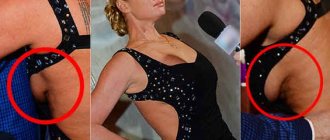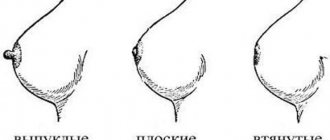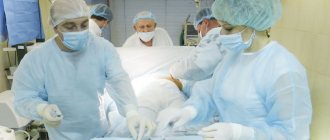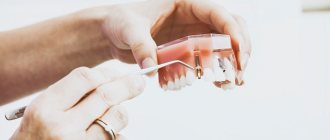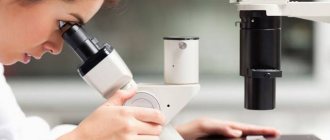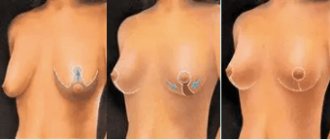Anatomy of nipples and their functions
In addition to the appearance of the bust, the appearance of the nipples is also important. They come in different shades, and unlike their size and roundness, they change slightly throughout life.
The main option of nipples is lactation. In men, nipples are vestigial, while in women they perform the important function of feeding the offspring. If they have a sunken shape, then the mother may have difficulty feeding the newborn.
Externally, the nipples look like small elevations with wrinkles, folds, and depressions, surrounded by skin of a slightly darker shade - the areola. They change color intensity over the course of a lifetime and even a month: during menstruation, during pregnancy and lactation, and when a woman is sexually aroused or cold, the nipples tend to harden and appear through clothing. If pimples on the areola become noticeable, this may be a harbinger of pregnancy.
An important feature of the female breast is increased sensitivity. The slightest touch can cause a severe reaction, not to mention squeezing or shock. Some girls note that even a cotton T-shirt worn over a naked body rubs their nipples. Changes in nipple hardness and fluctuations in sensitivity are completely normal for the female body and depend on various factors: temperature, emotional state, phase of the menstrual cycle.
Anatomy of nipples and their functions
Areola and nipples - what are they?
The shape of the areola is different. The most common ones are a circle, an oval or a blurred circle, the color of which blends with the skin around it. By type, the following groups of nipples and areolas can be distinguished.
- Flat
. Flat nipples are barely visible on the areola. They do not react to sexual stimulation or cold, remaining pressed into the surface, and this is a type of norm. - Convex
. Protruding nipples look like small buttons that rise 3-5 mm above the surface of the chest. The most typical appearance, characteristic of most representatives of the fair sex. - Not the same
. Sometimes girls have different shapes not only of their breasts, but also of their nipples themselves. Typically, such a feature is not a cause for alarm or a deviation; rather, it is a variation of the normal state after a girl’s puberty. - Retracted
. Sunken nipples, if they have been like this since adolescence, seem to be a normal phenomenon, but if this is discovered only after 16 years, then you should consult a mammologist for advice. This will help prevent the development of serious breast diseases. - With vegetation
. There may be a slight fluff on the nipple - natural vegetation throughout the skin. However, sometimes hair grows excessively, filling the chest, and then we are talking about male-type hair growth. Excessive hair growth indicates hormonal imbalances or is a side effect of taking certain medications. Women can remove hair for aesthetic purposes, but they should definitely find the cause of the phenomenon together with a gynecologist-endocrinologist. - Swollen
. In this case, the nipple, together with the areola, forms a soft cone, and during menstruation it rises along with the swelling of the mammary glands. - Lumpy
. If a girl has bumps or even bumps around her nipples, this is almost always a completely healthy phenomenon. However, it is worth regularly self-examining yourself for lumps and visiting a mammologist at least once a year. The lumps on the chest are called Montgomery glands. The nipple circumference with pimples is absolutely natural and normal. The irregularities may increase or decrease, but they do not pose any problem (except perhaps of an aesthetic nature). - Additional
. Some women may have more than two nipples. Unformed areolas are more like birthmarks and require careful medical supervision.
The most common shapes and types of female breast nipples
Causes of inverted nipple
At this point we want to talk not so much about the reasons for retracted papillae, but about situations when you need to go to the doctor.
If you have a small area of SAH, it is genetic. If the nipple is strongly pulled inward, most likely the milk ducts are short. This is not dangerous. But swollen glands and the following changes in the SAH area should alert you:
- The nipple has retracted, the color of the skin of the breast has changed, discharge from the excretory ducts of the mammary gland or pain has appeared, hurry to the mammologist. Such manifestations indicate breast disease, including cancer.
- If your areola shrinks, this is also abnormal. Sometimes the cause is called hypotrophy of the SAH region, caused by wearing tight underwear. In order for the tissues to stop supplying blood and undergo reverse development, the underwear must be very tight, and you must wear it constantly, which is unlikely. Consult your doctor.
Are you sure you don’t need to run to the hospital? The question remains, what to do?
Shade of nipples and areola
The color of the nipples and circumference may vary depending on the initial skin tone, metabolic characteristics, phase of the cycle, and the general state of the body (pregnancy, puberty, and others). Pink, beige, brown, coral and even chocolate for dark-skinned beauties - the shades can be very different. If the bulge itself differs from the color of the areola, this is not a deviation, although more often they still merge.
After breastfeeding, women note that the areola and nipple become brighter, darker, and more expressive. There are women whose nipple shade matches their skin tone or differs slightly - in this case, it is not easy to understand at first glance where the circumference ends and the bust itself begins. This makes some women uneasy. Fortunately, there is a procedure for permanent tattooing of the areola, which helps correct imperfections and make the circle richer, giving the breast a complete look and saving its owner from a possible complex.
Different color nipples
Why do breasts become large?
Why do some women have small breasts, others have medium-sized breasts, and others have large breasts?
Below is a brief overview of breast development and the reasons for breast enlargement.
Mammary glands are specialized skin glands that are formed at a very early stage of fetal development. Breast tissue grows along milk lines that run from the armpits to the groin. Most of the breast line tissue disappears before birth, with the exception of the area above the pectoral muscles. This area becomes the breast and nipple.
Sometimes some tissue remains as extra (ectopic) breast tissue in the armpit or as an extra nipple along one of the milk lines.
The chest consists of
- milk lobules, which form glands similar to sweat glands;
- ducts that carry milk from the gland to the nipple;
- connective tissue (tissue that holds everything together);
- subcutaneous fat;
- skin.
The tissues that make up large breasts are usually developed normally. A woman with large breasts does not necessarily have to have relatively more glandular tissue or more fatty tissue than a woman with smaller breasts.
The breast is attached to the skin and to the chest wall (muscles and fascia) by Cooper's ligaments. The strength of these ligaments varies from woman to woman, and women with weaker ligaments will be more affected by gravity than women with stronger ligaments.
To date, there is no surgical technique that can reliably prevent the effects of gravity on the breast.
The position of the nipples varies greatly from woman to woman, and very often the nipples are positioned asymmetrically on a woman's breast. The nipples may point straight down, straight forward, towards the armpits, or towards each other.
At birth, girls have only the main ducts of the mammary glands, as well as a small flat nipple. Breasts remain this way until a girl reaches puberty, when hormones cause the fat and connective tissue in her breasts to increase.
The ducts enlarge and lengthen, but the gland lobules that produce milk do not fully develop until pregnancy. At this time, the lobules expand and divide into smaller parts called alveoli.
Genetics
Body type is inherited, but not always as one might expect. We all know women with large breasts whose sisters and mothers are A or B cups. But your large breasts may be inherited from your paternal grandmother or an even more distant relative.
Likewise, your daughters may be shaped like you, or they may have breasts that look nothing like yours.
Hormones
Breast tissue is affected by almost all hormones produced by the body
Hormones from the ovaries, adrenal glands, pituitary gland and brain (hypothalamus) work together to influence breast growth and function starting at birth and continuing throughout a woman's life.
The most important hormone that causes breast enlargement is estrogen, which is secreted by the ovaries. Estrogen causes breast tissue to grow by attaching to cells at points called estrogen receptors. Women with excessively large breasts usually have normal levels of estrogen in the blood and a normal number of estrogen receptors. Therefore, the main scientific theory behind excessive breast enlargement is that some women's breast tissue is hypersensitive to estrogen.
You might assume that it is the glandular tissue in the breast that responds most to estrogen, but in fact it is the fibrous tissue and fat that are most sensitive to the hormone. The important point here is that breast enlargement for most potential breast reduction patients is due to an increase in hormone-sensitive fat and fibrous breast tissue, and not due to an increase in body fat that resides in the breasts and which can be expected to shrink with weight loss.
The first major change in breast size occurs during puberty. Girls can have breast buds as early as age eight, and breast development can precede other obvious signs of puberty by as much as two years. Breast augmentation may continue even after a teenage girl reaches her adult height.
Dramatic and often painful massive breast enlargement during hormonal stimulation during adolescence is called gigantomastia.
During pregnancy, a woman's breasts become enlarged and remain enlarged until lactation stops. Once a woman stops breastfeeding (or if she doesn't breastfeed at all), the mammary glands and the increased blood flow to her breasts begin to shrink.
These effects are the result of changes in hormone levels and take six months to a year to complete.
There is huge variation among women in the ongoing effects of pregnancy and breastfeeding on breast size. The final size and shape of a given woman's breasts after pregnancy depend both on how her breasts respond to temporarily elevated hormone levels and on the turgor of her skin.
Some women experience persistent breast enlargement that does not respond to weight loss. These women often find that their breast size progressively increases with each pregnancy.
For other women, the breasts return to approximately their pre-pregnancy size and shape.
Still others lose much of their original breast fullness due to shrinkage of the glandular breast tissue. Some of these women have low skin elasticity and are left with elongated, flat, sagging breasts. Even these women may experience significant symptoms associated with large breast size because the excess skin is heavy and does not improve with weight loss.
By the time a woman reaches thirty-five, ovarian hormone production begins to decline and the glandular tissue in her breasts begins to shrink further.
After menopause, when the production of ovarian hormones completely stops, the milk ducts of the gland degenerate, and the breast at this age begins to consist almost entirely of skin, fat and connective tissue.
Hormones taken as medications can cause breast enlargement or reduce the amount of breast tissue shrinkage that typically occurs during menopause. Both birth control pills (taken for contraception or to regulate your menstrual cycle) and hormone replacement therapy for menopausal symptoms can cause breast enlargement.
Obesity
The exact relationship between obesity and breast enlargement is unclear. Plus-size women don't necessarily have disproportionately large breasts, and most plus-size women who also have very large breasts say that losing weight has little effect on their breast size.
Women who gain weight after breast reduction surgery usually do not need to upgrade to a larger bra cup size.
Skin laxity
The laxity of your skin is a key factor in determining the shape and size of your breasts. Skin contains collagen and elastin, two important proteins that determine how well your skin resists gravity and responds to injury.
The quality of your skin's proteins is determined almost entirely genetically. If your skin's proteins are strong and tightly bound together, your skin can return to its original shape even after being stretched for a long time.
For a woman, the main test of skin elasticity is pregnancy. The typical woman ends her pregnancy with the double gift of a beautiful baby and extra skin on her chest and belly.
If you have stretch marks, they indicate that the collagen and elastic fibers in your skin are torn. These changes are permanent and, depending on the severity, are associated with varying degrees of skin laxity.
Obesity with subsequent weight loss affects the skin in the same way as pregnancy, as does the natural aging process. Because skin elasticity varies greatly from woman to woman, two women with the same breast size can have completely different breast shapes.
A woman with good skin turgor may have dense breasts, while a woman with poor skin turgor will complain that she has to constantly tuck her breasts into her bra.
Two factors that permanently damage skin proteins that you can control are exposure to ultraviolet light (from natural sunlight or tanning beds) and smoking.
Nipple direction and methods to correct it
The papillae can “look” in different directions, just like the breasts themselves. Straight, slightly down, in different directions, up. The direction changes depending on the tone of the breasts: if you are excited, the breasts rise, the nipples swell and protrude forward and slightly upward.
When the breasts swell before menstruation or in the first weeks of pregnancy, the nipples along with the areolas droop, while the mammary glands themselves increase (sometimes by 1-2 sizes). With age, the tone of the muscles that maintain volume and shape is lost, the breasts become flabby and sag. By the way, you won’t be able to pump up your chest with exercises; you can only strengthen the muscle frame and ligaments that hold the bust.
Where your nipples point can be adjusted in two ways. The first expensive and risky one is plastic surgery. The second is everyday and simpler: choose the right underwear so that your breasts look attractive in clothes, and accept the fact that every girl, girl, woman is individual and beautiful, regardless of the shape and size of the breast.
How does this intervention work?
The essence of the operation is the dissection of those connective tissue cords that hold the nipple in a retracted state and do not allow it to assume a normal position. But the volume of intervention already depends on the degree of nipple retraction - this determines how deeply it is necessary to penetrate into the soft tissues in order to sufficiently free the nipple and areola. In addition, specialists choose the correction method taking into account whether the patient intends to breastfeed the child in the future or not. If the answer is yes, the nipple retraction surgery should be performed in such a way that the milk ducts remain intact. Microsurgical techniques are used here to ensure high precision in all the doctor’s manipulations.
If a woman does not plan to breastfeed in the future, the situation becomes simpler. The clinic specialist simply dissects the connective tissue cords without isolating the milk ducts. This will not affect the result of the operation in any way.
